
Dear friends, I truly hope that you are enjoying the rainy weather as I am. The smell of fresh moist earth is lingering in all my senses. I am happy that I will be sharing this post about another one of autumn’s wonderful produce, the quince.
This is the perfect weather to harvest your quince, after the first rain of the season.
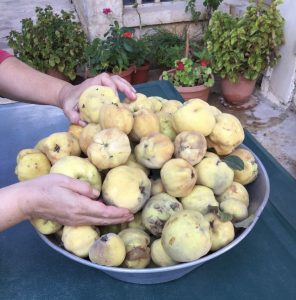
Freshly harvested Quince
Quince are large yellow fruits that ripen in autumn. They are a cross between pears and apples. Layers of fur cover their skin, but this can be easily rubbed off. This fruit that is pale yellow when raw, turns into a bright coral, even rich red when cooked. You may feel that quince is inedible, but when you cook it, this fruit is magically transformed, and you will be pleasantly surprised with its sweetness. When choosing them at the market or in your garden, always rely on your nose, pick those that are most fragrant. The quince that I used to cook all my batches for this year were harvested in different areas with different altitudes all over Lebanon.
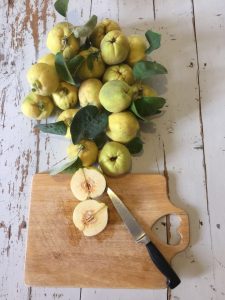
Quince ready for slicing
Fruits in general are a healthy part in our diet and the variety is enormous. Quince is one of those rare fruits that are loaded with nutrients, but most people are not aware of. Since this is the season for it, let’s start making the best use out of it. Whether you bake it, add it to stew, steam it, or make it into jam. (Jahna’s quince jam is now available in the market).
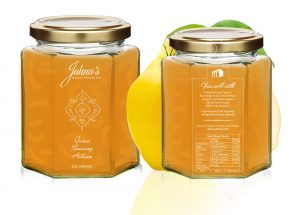
Jahnas quince jam
– Weight loss
– Treats ulcers
– Lowers blood pressure
– Lowers cholesterol
and much more…
In certain countries, for instance, Croatia, a quince plant is planted when a baby boy is born, as the tree is a symbol of fertility, love, and life. In Greece, during weddings, it was a custom that a Greek bride would nibble on a quince before entering the bridal chamber, as the quince came from the Levant with the Goddess Aphrodite, whom was considered sacred. In Brazil, it became the national tree that you can find all over the country. In Spain and Portugal, it is the Membrillo, a quince paste served with the traditional manchego cheese.
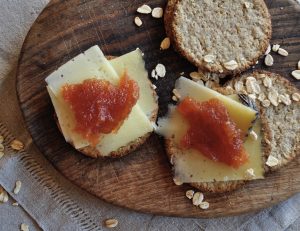
Manchego cheese and quince
In Lebanon, you will find it in grandma’s pantry all throughout autumn.
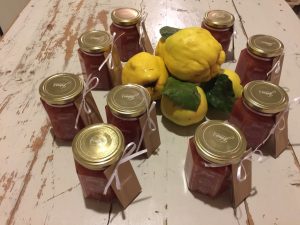
Ingredients:
– 6 cups quince (about 5 quinces, depending on the size of the quince), washed and grated
– 4 1/2 cups water
– 4 cups sugar
– 1/4 cup lemon juice
Method:
Prepare the quince by washing them and slicing them up in quarters. Remove and discard the cores.
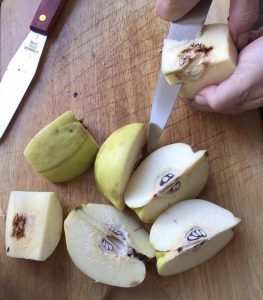
Slicing the quince
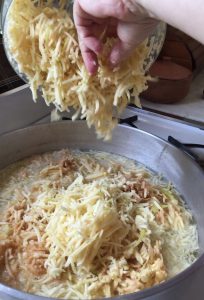
Shredded quince
Chop the quinces or shred using a shredder. Combine in water and lemon juice. Cook in a large sauce pan, bring to boil, and simmer until tender (should take around an hour). Stir in sugar until sugar is completely dissolved, then bring to boil for about 30 minutes. Test your jam, it should be jelly enough. Pour into sterilized jars.
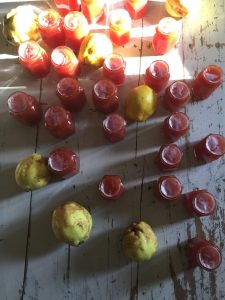
My grandma used to add a geranium leaf towards the end, around 10 minute before the jam is done. It gives it a special flavor.
I usually cook the jam outside in my garden so that I can enjoy the beautiful weather. As I was cooking this batch, two of my dear friends surprised me with their early visit carrying two boxes of quince from their village. They put on some gloves and participated in slicing the quince, measuring the ingredients, and stirring the jam. They even brought some lunch with them. Their surprise visit turned the whole day into a memorable one. How true it is when they say: “old friends are like gold”
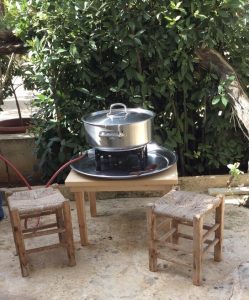
Cooking outdoors
There are several methods for doing this jam. The method introduced above, my personal favorite, gives you a smooth and sophisticated texture & taste. Sometimes the color can alternate from rose pink to coral red, depending on the fruit’s ripeness & quality. The color doesn’t really matter as long as the taste is good.
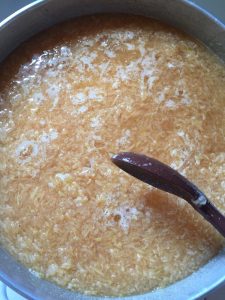
When you start, the quince will have its natural color
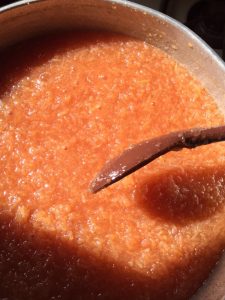
As you cook the jam, it will turn into a coral red color
In order for you to be able to test if the jam is ready, follow this tip:
– Place a few saucers in the freezer
– Drop a spoonful of the jam onto the saucer
– After few minutes, slide your index finger through, if it is set well, it will part in the middle
– If you find that the liquid is gathering up in the middle space then boil for few more minutes
Quince is exceptionally good in stews, baked in the oven with a leg of lamb or fish. It can be either boiled or steamed. Drizzle some honey and sprinkle some cinnamon on top to give it a delicious kick. This will add flavor to your dishes. I actually did that with my baked fish for our Sunday lunch.
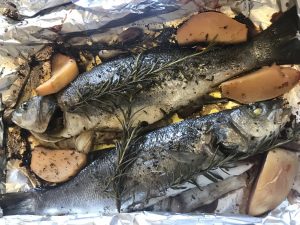
Quince baked with fish
* Essential tip: avoid green immature Quince, they are sour, bitter, and inedible.
Beauty grabs attention, personality grabs the heart, I say a compassionate chef grabs both.
With love, Jahna
3 Comments
Alf 3afieh Jahna 👏👌👏
Hi Jahna I just want to thank you so much for sharing with us all your hand made work & for the useful tips.
For me it’s a treasure that will pass from generation to genaration acknowledging the benefits of nature.
Knowing to pick the right fruits & veggies,the right utencils & most important the cleanness.
Bless you Jahna.
Thank you Lena for your constant support. We are all learning together. I am glad that you are enjoying my posts.